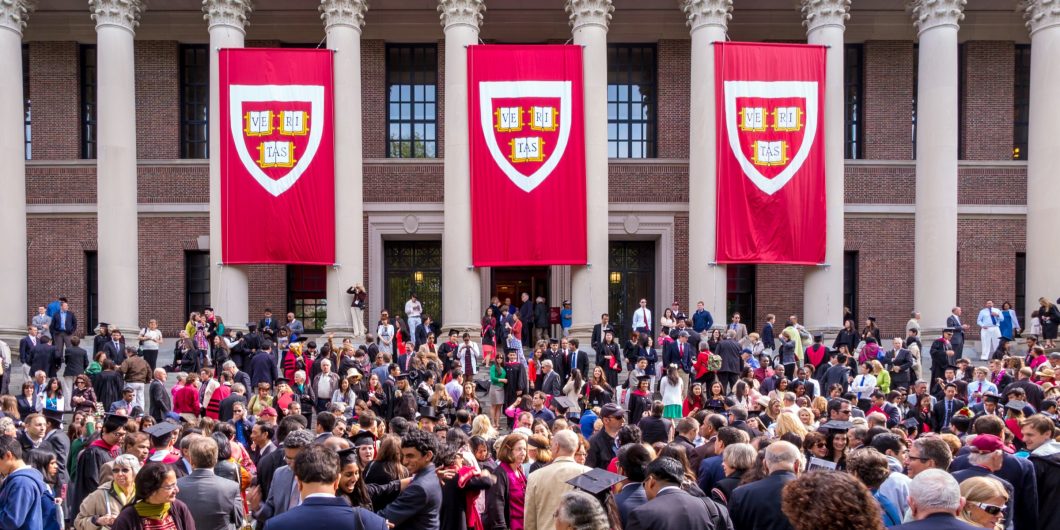The only way to change the university’s direction is strong leadership from the top, and that doesn’t appear likely.
The Ivy League's Race Problem
Along with its academic leadership of American higher education, the Ivy League now seems destined to be the source of the definitive, and therefore practically permanent, resolution of the issue of racial preferences in college admissions—and very likely in society as a whole. Federal cases alleging illegal and unconstitutional racial discrimination are now pending against Harvard, Yale, and Princeton.
Harvard
On November 12, the First Circuit Court of Appeals in Boston affirmed the decision of the federal district court in Boston vindicating Harvard’s use of racial preferences in admissions. Five years ago, Students for Fair Admissions (SFFA) had filed a civil-rights lawsuit against Harvard University claiming a pattern of discrimination against Asian Americans in admissions. Alleged are violations of the Equal Protection Clause and Title VI of the Civil Rights Act of 1964, with its prohibition of racial discrimination by entities, like Harvard, that receive federal financial assistance. The Trump Justice Department had intervened on the side of SFFA.
Describing the racial makeup of the recently admitted classes as “remarkably stable,” SFFA’s case is, at bottom, almost pre-law and simply an appeal to common sense. Over the four-year period of 2014-2017, the percentages of overall admitted students who were Asian Americans were 18, 18, 20, and 20 percent, respectively. There was a similar pattern for other racial groups: African Americans were admitted at the rates of 11, 12, 10, and 11 percent, respectively, over the same four-year period. For Hispanic Americans, it was 10, 12, 11, and 11 percent. The rates for whites were 48, 49, 52, and 53 percent. Res ipsa loquitur.
Yet in their respective 130- and 104-page decisions, the district and appeals courts obscure and avoid any direct consideration of the essential facts of the case. What SFFA claims is a matter of simple statistics, which anyone can understand, becomes lengthy and sophisticated statistical analyses and “models” in the two decisions. This is a new kind of constitutional law.
Whether Harvard uses race in its admissions policy and practices is not an issue in the case. For, as the appeals court states, “Harvard admits that race is considered.” Or as the district court says, “the racial composition” of the applicant pool is tracked as a matter of policy and practice “throughout the admissions process.” The issue is whether Harvard’s race-conscious admissions process engages in quotas or racial balancing. Both courts base their decisions on the 4-3 holding of the Supreme Court in the 2016 case of Fisher v. University of Texas in which the Court ruled that Texas’ use of race as a “plus” in admissions was narrowly tailored and constitutional as a legitimate educational goal serving diversity.
The Boston district and appeals courts reach the conclusion that Harvard did not have numerical racial quotas in admissions, unlike the 16 reserved places in the 1978 Bakke case. Likewise, both courts go on to hold that Harvard did not engage in racial balancing—that is, in the words of the district court, it did not make its admission decisions according to “some specified percentage of a particular group because of its race or ethnic origin.” In Grutter v. Bollinger (2003), the Court held that using a “specified percentage” for racial balancing is “patently unconstitutional.”
The two courts upheld Harvard’s self-vouching contention, purportedly proved by trial testimonies of its staff and by investigations by no fewer than three of its own internal committees, that neither any person nor the admissions process itself had any racially discriminatory intent. (Perhaps it is telling, though, that in 2020, it has become necessary for two federal courts to scrutinize Harvard and report to the nation that it does not employ racists or practice racism.)
When dealing with the four-year admissions statistics, both courts found that there was an overall bias against Asian Americans. As the district court put it, despite Asian American “strength across multiple dimensions” of the admissions process, there are “fewer admitted Asian Americans” than what might be expected. But the two courts, invoking the principle of statistics that “correlation does not prove causation,” ruled nonetheless that the bias was only “correlated” with and did not “cause” the disparity. It was not statistically significant. So as a conclusion, Asian Americans stand out in almost every aspect of admissions, but apparently because Harvard has no explicitly stated racial-preference policy or identified racial thinkers on its staff, the resulting uniform admission rates in the years 2014-2017 have no cause. As for using alternatives to race as admission criteria (financial neediness, targeted recruitment, or the elimination of early admissions, for example), Harvard averred and the courts agreed that Harvard had tried those and found that they were not as effective for the achievement of educational diversity.
A public self-accusation by Princeton University got the attention of the U.S. Department of Education.
But correlation does indicate causation when the relationship between two variables is sufficiently strong. Here, the “dependent variable,” actual admissions, is not even a variable, that is, it did not vary in any statistically significant way across four years. That is SFFA’s point. Harvard contends that it engages in a “holistic” and “individualized” admissions process. Through long and dense holding forth, the two courts concluded that the university was doing that, despite the non-individualized and racially patterned results. As of the date of this writing, SFFA has not asked the appeals court to review en banc or filed an appeal to the Supreme Court.
Yale
In its Complaint filed in Connecticut federal district court in October, the Justice Department’s Civil Rights Division asserts that Yale, “for at least the last 50 years,” has engaged in a “standardless, intentional use of race” in its admissions. The Complaint alleges that the university, in violation of Title VI, “instructs” application “readers” and admission officers and committees “to treat the race of a racially-favored applicant as a positive factor” at each stage of the application process. Those applicants are “mostly Black and Hispanic applicants.”
In the first paragraph of the Complaint, the Department quotes the racial-quota case of Richmond v. Crosan (1989), for the principle “that public dollars, drawn from the tax contributions of all citizens, do not serve to finance the evil of private prejudice.” SFFA has filed a motion to intervene as an additional plaintiff in the case essentially in support of the Department’s Complaint. But SFFA goes further, and though it does not explicitly ask that Grutter, for instance, be overturned, it nevertheless “seeks a broader injunction prohibiting Yale from ever using race as a factor in admission” (emphasis in original).
The Complaint gives racial details from the admitted classes of 2017 and 2018. For example, in the eighth decile of academic ratings (those between 70 and 80 percent academically) of applicants in those two years, the admission rates were “8.40% for White applicants; 6.20% for Asian applicants; 48.99% for Black applicants; and 21.12% for Hispanic applicants.” Thus, “Black applicants in the Eighth Academic Index Decile had nearly eight times the likelihood of admission as Asian applicants in the same decile.” By comparison, “The overall admit rate for applicants to Yale College in the Eighth Academic Index Decile was 9.88%.” For the Sixth Academic Index Decile, the admission rates in those two years were “6.53% for White applicants; 3.83% for Asian applicants; 27.95% for Black applicants; and 18.02% for Hispanic applicants.” “The overall admit rate for applicants to Yale College in the Sixth Academic Decile was 8.19%.”
Continually, for the years 2001 through 2017, Yale “engaged in racial balancing,” the Complaint alleges, by varying the black admission rate at only 1 percent from the previous year and the Asian admission rate at only 1.3 percent.
The Justice Department has agreed to SFFA’s motion to intervene, and Yale has opposed it. As of the date of this writing, the court has not yet ruled on it, and Yale has been granted an extension to file its answer to the Complaint.
Princeton
In what in another time would be considered a stunning and almost incomprehensible admission, another Ivy League pillar of the American academy, Princeton University, issued a public statement on September 2 stating that “racism . . . persist[s] at Princeton as in our society . . . sometimes by conscious intention.” Continuing, Princeton president Christopher L. Eisgruber held that, despite improvement in recent decades, “[r]acist assumptions from the past also remain embedded in structures of the University itself.” For example, Princeton has only a single program in “African studies” while maintaining nine departments and programs “organized around European languages and culture.” Eisgruber announced several very specific “diversity” goals, including increasing “by 50 percent” the “number of tenured or tenure-track faculty members from underrepresented groups,” not in the indefinite future but “over the next five years.”
Princeton’s public self-accusation got the attention of the U.S. Department of Education. In light of Princeton’s annual receipt of federal funds with the accompanying prohibition that no receiving entity may discriminate on the basis of race, the Department on September 16 made a demand on Princeton for relevant records since 1983.
Because of Princeton’s now “admitted racism,” the Education Department stated flatly that it is concerned that the university’s annually required “nondiscrimination and equal opportunity” assurances “may have been false, misleading, and actionable substantial misrepresentations.” The Department went so far as to warn Princeton that its answers were subject to federal criminal laws for materially false statements in matters within the jurisdiction of the federal government.
Thus, the Trump Justice Department has accused the elite of the elite in American higher education of using federal tax dollars to practice illegal and unconstitutional racial discrimination. Will the Biden Justice Department follow through? (And, for that matter, why do these wealthiest of American institutions even need federal financial “assistance?”) Regardless, SFFA is the original plaintiff in the Harvard case, so that case will continue. And can Princeton’s dramatic public confession of racism be ignored by the Justice Department?
Regardless of their future resolution, these three cases have brought attention to the racial weighting used by the most elite universities, prompted renewed questioning of affirmative-action law, and perhaps demonstrated the need for the Supreme Court to articulate a better approach to race.


